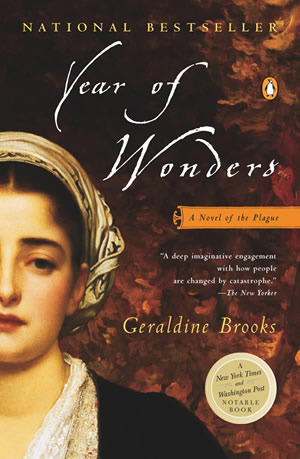Review: Geraldine Brooks’s “Year of Wonders”
by Miles Raymer
Geraldine Brooks’s Year of Wonders is a fictionalized account of the 1665 plague outbreak in Eyam, England. Upon realizing its situation, this small but noble village decided to self-quarantine in an effort to stop the disease from spreading to other communities. With few verifiable details about exactly what occurred in the fourteen months the residents of Eyam spent fighting for their lives, Brooks has a lot of latitude to let her imagination run wild. What she produced is an engaging story with a silly ending.
There are lots of reasons to praise Year of Wonders. Throughout the book, Brooks demonstrates an impressive command of 17th-century diction, syntax, and dialogue, adding strong layers of realism from her research of the era. Her imagery is inviting and vivid, especially her tactile descriptions of life in Eyam:
There are some who imagine that the work of a housemaid is the dullest of drudgery, but I have never found it so. At the rectory and at the Bradford’s great Hall, I found much enjoyment in the tending of fine things. When you have been raised in a bare croft, eating with wooden spoons from crude platters, there are a hundred small and subtle pleasures to be garnered in the smooth slipperiness of a fine porcelain cup under your hands in a tub of soapsuds or the leathery scent of a book as you work the beeswax into its binding. (loc. 594-600, page 40)
The housemaid who tells the story is Anna Frith, an intelligent and curious widow whose husband died in a mining accident. Anna is endearing from the start and easy to root for––a winning protagonist to be sure. It is through her eyes that we discover the “wonders” that emerge as the townsfolk “set about learning to live in the wide green prison of our own election” (loc. 1626, page 117). These include the baseline horrors of the Black Death and a series of plague-induced community events that are perhaps even more terrible than the disease itself. Brooks’s depiction of the totalizing helplessness experienced by this benighted population will help modern readers generate gratitude for our comparatively better situation.
There are encouraging “wonders” as well: unexpected camaraderie in hard times, new families formed as others are torn asunder, lessons learned about healing and perseverance, and moments of mental beauty that puncture Anna’s grim reality. My favorite of these was the fleeting respite she finds in a lozenge of opium:
Time turned into a rope that unraveled as a languid spiral. One strand widened into a broad, swooping curve on which I could glide, drifting easily like a breeze-born leaf. The zephyr that carried me was mild and warm, even as I soared in its currents high over the White Peak, breaking through the gray clouds and into a place where the sun so dazzled that I had to close my eyes. Somewhere, an owl hooted, and the note seemed to be pulled and stretched, endless, rich, like the rising call of a hunter’s horn, and then a score of horns, sounding all at once and in the sweetest harmony. The sun glinted off the serried instruments and then I could see the notes of music, molten, dripping like golden rain. Where they touched the ground, they did not scatter but gathered, leaping up again each upon the other. Walls rose, and soaring arches, building a shining city of fantastic towers, one growing out of the next like tight buds unfurling from a thousand various stems. The city was all white and gold, curving in a wide arc round a sea of sapphire. (loc. 1884-96, page 138)
The opening and middle acts of Year of Wonders are terrific, but the book falters as it comes to a close. There are several distinct reasons for this, but they can all be understood together as forms of contemporary wish fulfillment. Readers generally shouldn’t begrudge a turn of good fortune for a protagonist who’s been through hell, but after the narrative’s nadir, Brooks goes too far in the opposite direction. In a very short time, Anna gains a level of knowledge and autonomy that feels increasingly unbelievable for a peasant widow, especially in this historical period. The book’s epilogue reveals what has become of her some years later, which I can only describe as more representative of a fairy tale than a piece of historical fiction. Maybe that’s what Brooks was going for, but it didn’t work for me.
Rating: 5/10

Excellent final thought!